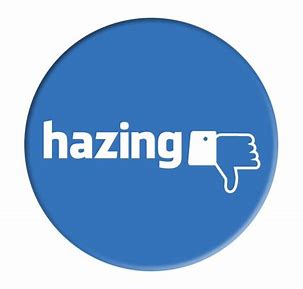 As a student leader, do you see yourself in a position in your club, group, organization, or athletic team? Or do you recognize the role and responsibilities you have to your fellow students you lead? The view of a position can hinder student leaders from taking ownership for the responsibilities you have for your fellow members or teammates. You may think or assume that hazing does not happen on our college campus.
As a student leader, do you see yourself in a position in your club, group, organization, or athletic team? Or do you recognize the role and responsibilities you have to your fellow students you lead? The view of a position can hinder student leaders from taking ownership for the responsibilities you have for your fellow members or teammates. You may think or assume that hazing does not happen on our college campus.
The term hazing generally draws society’s attention to fraternities and sororities. However, institutions also experience hazing incidents within athletic teams, marching bands, and campus organizations. Although specific to each university, campus clubs and organizations may cover areas from academics, club sports, co-curricular activities, intramurals, and social groups on campus. For institutions in Texas, the State Legislature defines hazing as: any intentional knowing, or reckless act, occurring on or off campus of an educational institution, by one person alone or acting with others, directed against a student that endangers the mental or physical health or safety of a student for the purpose of pledging, being initiated into, affiliating with, holding office in, or maintaining membership in any organization whose members are students at an educational institution (§ 37.151.6).
Research from the HazingPrevention.org indicates that over half of college students involved in clubs, teams, and organizations experience hazing. The study Hazing in View: College Students At Risk: National Study of Student Hazing by Allen & Madden reveals the vast array of areas across the campus where hazing occurs. Although the percent of students experiencing hazing in an honor society is far less than those who experience it with an athletic team or fraternity and sorority, the fact remains that it is still happening. Hazing rituals date back to the 1800’s. The punishment for hazing incidents in more recent court cases appear more frequent and at times with higher consequences and penalties than hazing cases in the 1970’s. Nuwer with the Hazing Clearinghouse shares that hazing incidents have “claimed at least one life a year on college campuses from 1970 to 2014” (p. 1). In a 40-year comparison, Bauer-Wolf (2017) in a recent article contrasts how Chuck Stenzel’s death in 1978 saw no criminal charges brought forward whereas Timothy Piazza’s case in 2017 prosecuted 18 people and eight received charges of involuntary manslaughter. Bauer-Wolf (2017) describes the Piazza case and convictions as “one of the biggest prosecutions of hazing in history” (p. 1).
Longstanding traditions requiring campus administrators’ purview may or may not directly involve hazing, but rather impact the safety of their students. Van Jura declares, traditions “have the potential to teach students about the history of their institution, provide a means of building community, instill common values that span generations of students, and generate pride and enthusiasm” (p. 107). The Student Affairs professionals need to educate current members, pledges, and alumni governing boards to ensure accountability for the risk management of hazing. Dr. Peter Lake, director of the Center for Excellence in Higher Education Law and Policy at Stetson University, identifies a solution to hazing may not be in the punishment rendered rather than a focus on justice for the process to abate hazing (Bauer-Wolf, 2018).
An educational model must include current students, club and organization advisors, coaches, and alumni of the institution involved in the various groups. A focus on ethical and moral leadership development provides the educational approach to impact social change. Debora Liddell and Diane Cooper in their study of moral development acknowledge that “moral” and “ethical” development are synonymous terms (p. 14). Linda Trevino and colleagues, in the article Inspiring and Equipping Students to be Ethical Leaders, identify five essential behaviors of an ethical leader from their years of research. The essential behaviors consist of “integrity, fairness, communicates ethical standards, care and concern for others, and shares power” (p. 6).
The Association of American Colleges and Universities (AACU) established five core commitments to “foster personal and social responsibility on campus”. The AACU’s 5 core commitments are “striving for excellence; cultivating personal and academic integrity; contributing to a larger community; taking seriously the perspectives of others; and developing moral competence in thought and deed”. These core commitments provide structure for developing student leaders to serve in roles not positions and take responsibility for the students they lead. As student leaders, if you lead by example – in giving others respect you in turn will receive the respect of others. This will allow students, faculty, staff, and alumni to partner in the efforts to abate hazing on their campus.
Stacey Martin, M.Ed.
Doctoral Student, Doctorate of Leadership, Hardin-Simmons University
Dean of Students, Hardin-Simmons University
smartin@hsutx.edu
References
Allen, E. & Madden, M. (2018). National hazing study: Hazing in view. Retrieved from: https://www.stophazing.org/hazing-view/
Bauer-Wolf, J. (2017). College hazing becoming easier to punish. Inside Higher Ed, May 24. Retrieved from: https://www.insidehighered.com/news/2017/05/24/college-hazing-becoming-easier-punish.
Liddell, D. & Cooper, D. (2012). Moral development in higher education. New Directions for Student Services, 139(Fall), 5-15.
Nuwer, H. (2014). Stopping hazing in college and high school athletics. Athletic Business, July. Retrieved from: https://www.athleticbusiness.com/athlete-safety/stopping-hazing-in-college-and-high-school-athletics.html.
Schwartz, A. (Summer, 2015). Inspiring and equipping students to be ethical leaders. New Directions for Student Leadership, 146, 5-16. DOI: 10.1002/yd.20131.
Texas Hazing Law (1995), TX State Legislature, Education Code § 37.151, Subchapter F.
Van Jura, M. (2010). Tradition today: How student affairs professionals can strengthen and preserve campus traditions. The Vermont Connection, 31, 107-116.

